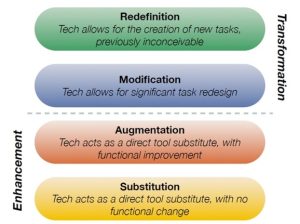Note: Free users of ChatGPT should currently be able to upload documents.
I’m doing it. Diving head first into my 4th course on AI this weekend :-O The “ChatGPT Advanced Data Analysis” Coursera course by Jules White of Vanderbilt University, as well as the other AI related courses from the same awesome professor, are proving to be very useful! I’ve learned so much – kind of too much to be honest. I’m going to have to spend the next week or two elaborating on the concepts and putting the tools and patterns into use so I don’t lose them entirely.
One of the things I’ve come to value most, because of its transformative power, is ChatGPT’s Advanced Data Analysis (ADA) tool. It really does have the potential to fundamentally reshape how we, as learning experience design professionals, get stuff done.
Let me say that again, only better – This tool isn’t just about processing data—it’s about fundamentally reshaping how we approach our work.
But wait
Before I go on, and I do plan to go on and on about this, I also have to say that a lot of what we do with AI today is not what we’ll be doing with it in the future. Remember the SAMR model?

When it comes to AI most of what we’re doing is using it as a direct substitute or with a bit of augmentation. Soon, I believe, we’ll see a shift into really changing and completely redefining how we design and deliver (like it’s a pizza right?) learning experiences in the workplace.
However, to get there we have to go through here. We have to learn how to use the tools at a basic level. It’s like learning to drive. You start slow and on straight roads with limited traffic and work your way up to the freeway. You don’t start out driving in the Grand Prix.
What is Advanced Data Analysis?
This feature of ChatGPT, and I’m pretty sure all the rest of the main AI players, goes beyond basic queries. It enables deep, automated analysis of documents and datasets. Yes, even pdf’s! Whether it’s synthesizing information from that massive report or extracting actionable insights from learning materials, it’s an extremely valuable, multi-use tool that brings efficiency and increased effectiveness to our work. It makes us better and lets us spend time doing the stuff we don’t get nearly enough time for… like being creative and innovative!
The Problem It Solves
If you’ve been in this profession for any length of time, you’ve probably had to manually extract learning objectives from ridiculously long documents. ‘Cos as much as we hate it, content often precedes analysis and design in corporate settings. Welp, the Document Data Extraction Pattern (really just a fancy way to say a “prompt”) used with the Advanced Data Analysis tool (or function, I can’t decide) that is now a part of ChatGPT, automates this process. It pulls out the necessary data and presents it in a structured format, ready to be used in course design, development, or even evaluation. This saves time. More importantly it saves sanity. It may also help ensure consistency across projects and a multitude of other things we haven’t realized yet.
True story
Don’t tell my boss, but I was so excited about this that I did some work with it this weekend. I saved myself, my team, and taxpayers probably 20 hours of work (maybe more) by using this and a few other prompts to analyze an 80 page rubric I had designed. Ya, I did that… my bad… I was able to reduced the behemoth it to 4 pages by using smarter prompting. I was also able to match all the initial criteria with the new ones, in a seperate document so I could manualy check more easily. Before I found these prompts I had planned to print the rubric out (say goodbye to all my ink) then cut it up and basically do a card sort activity to pull all the similar criteria together. Truely, a life saver!
How does one perform this magic!?
Upload, upload, upload. You can simply upload publicly available reports, instructional materials, or any complex document that requires thorough data extraction. Then you can have a conversation with it. The conversation starter is the prompt using the Document Data Extraction Pattern
The key term here is “publicly available”. If you are using the non-enterprise version of any AI platform, please, for the love all that is good and right, do not upload anything into any AI platform, or other cloud application, that contains any kind of personal, private, confidential or otherwise harm or risk inducing data. You have been warned.
What It Does for You
This prompt pattern allows you to quickly gather and organize the key elements you need, whether it’s for creating new learning content, evaluating existing resources, or reducing your rubric to something more easily managed by mere mortals aka SMEs. It streamlines the process, enabling you to focus on the creative and strategic aspects of your work. (Que the trumpets)
Quick Copy/Paste Prompt Pattern
K, here we go. Here is the spell… uhm… I mean prompt:
Extract all instances of [insert the specific data type, e.g., training objectives, key metrics] from the uploaded document, and organize them into a structured format that can be directly used in learning materials or reports.
Simply upload your document, add a well designed and thought out prompt like the one above, and let ChatGPT and it’s Advanced Data Analysis handle the rest.
If you want to learn more – and there is soooo much more – there are lots of excellent courses available.
I’m loving the Coursera ones but I started out with free courses from Apolitical and InnovateUS (these are mostly for government employees) then graduated to LinkedIn Learning. Whatever you do, do it soon. There is a learning curve and the faster you begin the better prepared you’ll be for what comes next in L&D and AI.
Sources
- coursera.org – ChatGPT Advanced Data Analysis
- analyticshacker.com – ChatGPT Prompts for Data Analysis
Written as part of an assignment in this course. Content generated in part by ChatGPT 4o, edited and rewritten numerous times by me.

